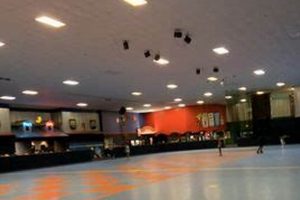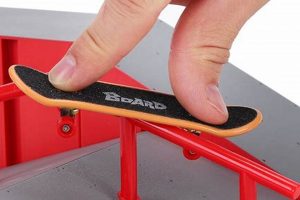Protective equipment designed for skateboarding mitigates the risk of injury during falls and impacts. This equipment commonly includes items such as helmets, knee pads, elbow pads, wrist guards, and padded shorts. These items offer a physical barrier against abrasions, contusions, fractures, and head trauma associated with skateboarding.
The implementation of such safety measures can significantly reduce the severity of injuries, allowing individuals to pursue the activity with increased confidence and decreased apprehension. Throughout the history of skateboarding, the development and adoption of impact-resistant gear have played a vital role in promoting participation and progressing skill levels within the sport.
The subsequent discussion will delve into the specific types of protective skateboarding gear available, the materials used in their construction, and the considerations to keep in mind when selecting appropriate safeguarding equipment. Further analysis will examine the impact of this gear on performance, the evolution of design, and current trends in skateboard safety.
Protective Skateboarding Gear
Effective protection is paramount for a safe skateboarding experience. Choosing and properly utilizing the correct gear significantly reduces the risk of injury and allows for confident skill progression.
Tip 1: Prioritize Head Protection: A properly fitted helmet is non-negotiable. Select a helmet certified by recognized safety standards, such as ASTM F1492, and ensure it sits snugly on the head, covering the forehead. Replace helmets after any significant impact, as the protective structure may be compromised.
Tip 2: Invest in Joint Support: Knee pads and elbow pads provide crucial abrasion resistance and impact absorption. Opt for pads with a durable outer shell and comfortable, impact-absorbing inner padding. Ensure a secure fit that allows for a full range of motion.
Tip 3: Protect Extremities: Wrist guards safeguard against common wrist fractures and sprains. Choose guards with a rigid splint that provides support to both the palm and back of the wrist. Correct sizing is essential for optimal protection.
Tip 4: Consider Padded Shorts: Padded shorts offer added protection for the hips, tailbone, and thighs, areas prone to bruising and impact injuries, especially for beginners learning new tricks.
Tip 5: Ensure Proper Fit: Ill-fitting protection offers reduced effectiveness. Consult sizing charts and, ideally, try on gear before purchase to ensure a snug, secure fit that does not restrict movement excessively.
Tip 6: Regularly Inspect Equipment: Before each session, inspect gear for signs of wear and tear, such as cracks, loose straps, or damaged padding. Replace worn or damaged equipment immediately to maintain optimal protective capabilities.
Tip 7: Layer for Enhanced Protection: Consider wearing layers of protective clothing, such as long-sleeved shirts and pants, in addition to pads, to minimize abrasions and cuts during falls.
By adhering to these recommendations, skateboarders can significantly reduce their risk of injury and enjoy the sport with greater security and confidence. Proper protective measures are an investment in long-term participation and skill development.
The following sections will explore specific products, materials science related to protection, and evolving trends in skateboarding safety equipment.
1. Impact Resistance and Skate Armor
Impact resistance forms a cornerstone of effective protective skateboarding equipment. Skateboarding inherently involves the risk of falls and collisions, making the ability of armor to absorb and dissipate impact forces critical for injury prevention. Without sufficient impact resistance, protective gear provides limited benefit, leaving the wearer vulnerable to fractures, contusions, and head trauma. The relationship between impact resistance and the effectiveness of the skateboarding equipment is causal: higher impact resistance directly translates to reduced injury risk.
The design and materials used in impact-resistant safeguarding equipment are specifically chosen to manage kinetic energy. High-density foams, such as expanded polystyrene (EPS) or dual-density foams, are commonly incorporated to absorb impact by deforming upon contact. Hard outer shells, frequently made of polycarbonate or polypropylene, serve to distribute the impact force over a larger area. The efficacy of these materials is rigorously tested in laboratory settings, simulating real-world falls and impacts. For example, certified skateboarding helmets must meet specific standards for impact absorption, as measured by the force transmitted to the head during a drop test. Knee and elbow pads undergo similar testing to assess their ability to protect against joint injuries. Successful execution of complex skateboarding maneuvers, therefore, hinges not only on skill but also on the reliable impact resistance of the protective equipment worn.
In summary, impact resistance is a fundamental and non-negotiable characteristic of quality skateboarding safeguards. The selection of protective gear should prioritize products engineered with materials and designs that demonstrably minimize the effects of impact forces. Ongoing advancements in materials science and engineering continue to improve the impact resistance of skateboarding equipment, contributing to enhanced safety and enabling the continued progression of the sport. Understanding the principles of impact resistance empowers skateboarders to make informed decisions about their protection, fostering a safer and more enjoyable skateboarding experience.
2. Abrasion Protection
Abrasion protection constitutes a critical function of protective skateboarding equipment. The dynamic nature of skateboarding exposes participants to a high risk of falls, often resulting in contact with abrasive surfaces such as asphalt or concrete. The ability of protective gear to withstand and mitigate abrasion is therefore paramount in preventing skin injuries and minimizing the severity of accidents.
- Material Composition
The materials used in protective gear directly influence its abrasion resistance. Durable, synthetic fabrics such as nylon and polyester, often reinforced with coatings like polyurethane, are commonly employed. Hard outer shells, typically constructed from high-density polyethylene or polypropylene, provide a robust barrier against abrasive forces. The selection of appropriate materials is crucial in maximizing the lifespan and effectiveness of protective equipment.
- Construction Techniques
Construction methods play a significant role in abrasion resistance. Reinforced stitching, strategically placed seams, and multi-layered designs enhance the overall durability of protective gear. Overlapping panels and integrated reinforcement zones provide additional protection in high-wear areas, such as the knees, elbows, and palms. Careful attention to construction details ensures that the equipment can withstand the rigors of skateboarding.
- Coverage Area
The extent of coverage provided by protective gear directly impacts its ability to prevent abrasions. Full-coverage designs, such as padded suits or integrated armor systems, offer comprehensive protection against a wide range of potential contact points. Targeted protection, such as knee pads and elbow pads, focuses on specific areas vulnerable to abrasion. The selection of appropriate coverage should be based on the individual’s skill level, skateboarding style, and risk tolerance.
- Testing and Certification
Established testing protocols and certification standards ensure that protective equipment meets minimum requirements for abrasion resistance. Standards such as those developed by ASTM International specify testing methods for evaluating the ability of materials to withstand abrasive forces. Certification by recognized organizations provides assurance that the equipment has been rigorously tested and meets accepted performance criteria.
In conclusion, abrasion protection is an indispensable attribute of effective skateboarding protective gear. The interplay of material composition, construction techniques, coverage area, and adherence to testing standards collectively determines the ability of equipment to minimize the risk of skin injuries. Prioritizing abrasion resistance in the selection of protective gear is essential for promoting a safer skateboarding experience. Enhanced abrasion resistance allows participants to engage with skateboarding in confident and focus more on their skill development.
3. Proper Fit
The effectiveness of protective skateboarding equipment, commonly referred to as skate armor, is inextricably linked to proper fit. Ill-fitting armor, irrespective of its inherent material quality or design, provides diminished or negated protection against impact and abrasion. A causal relationship exists: improper fit directly reduces the armor’s capacity to perform its intended safeguarding function. If skate armor is too loose, it shifts during impact, exposing vulnerable areas. If it is too tight, it restricts movement, potentially contributing to a fall. For instance, a helmet that slides back during a fall leaves the forehead unprotected, negating the helmet’s primary purpose.
Achieving correct fit requires careful consideration of sizing charts provided by manufacturers, as well as physical trials of the equipment when feasible. Adjustment mechanisms, such as straps and buckles, play a crucial role in fine-tuning the fit to individual body dimensions. The armor should conform closely to the body without causing constriction or inhibiting range of motion. As an example, correctly fitted wrist guards offer rigid support to the wrist joint, preventing hyperextension during a fall, whereas loose guards may slide out of position, providing minimal support. Regular reassessment of fit is necessary, particularly for growing adolescents, to ensure continued protection.
In summary, proper fit is not merely a comfort consideration but a fundamental requirement for skate armor to perform its intended protective function. The selection and adjustment of skate armor must prioritize achieving a secure and conforming fit that does not impede movement. The practical significance of this understanding lies in minimizing the risk of injury and maximizing the potential for safe and confident skateboarding.
4. Mobility allowance
Mobility allowance within protective skateboarding equipment directly influences a skater’s control, balance, and ability to execute maneuvers. Restrictive equipment impedes natural movements, increasing the likelihood of falls, the very events it aims to prevent. Skate armor must therefore strike a balance between protective coverage and freedom of movement. For example, overly bulky knee pads may hinder a skater’s ability to bend their knees fully, impacting their center of gravity and compromising their stability during technical tricks. A causal relationship exists: decreased mobility allowance increases the risk of falls due to compromised control.
Designs that incorporate articulated joints, flexible materials, and strategically placed padding contribute to increased mobility allowance. Articulated knee and elbow pads, for instance, mimic the natural movement of the joints, allowing for a greater range of motion without sacrificing protection. Similarly, wrist guards with flexible splints permit wrist flexion and extension, essential for maintaining balance and performing specific skateboarding techniques. The integration of breathable materials and lightweight construction further enhances comfort and reduces the burden on the skater, contributing to improved mobility and overall performance. Furthermore, skateboarding gear that correctly size provides suitable mobility.
In summary, mobility allowance is a critical design consideration in skateboarding armor. Skate armor must not be bulky and provide as much mobility as possible. The practical significance of this lies in enabling skaters to confidently push their limits without sacrificing safety. Therefore, the selection of protective gear should prioritize equipment that offers a balance between robust protection and unrestricted movement, facilitating both safety and performance.
5. Durability
Durability is an essential attribute of skate armor, impacting its longevity, reliability, and cost-effectiveness. Protective skateboarding equipment is subjected to repeated impacts, abrasions, and environmental stressors. The durability of this equipment directly influences its ability to provide consistent and reliable protection over time.
- Material Selection and Construction
The materials used in skate armor construction are primary determinants of its durability. High-density plastics, reinforced fabrics, and robust stitching techniques contribute to increased resistance to wear and tear. For example, knee pads utilizing ballistic nylon and double stitching are demonstrably more durable than those constructed from thinner, less resilient materials. Properly selected and constructed materials extend the lifespan of the armor, reducing the need for frequent replacements.
- Impact Resistance Degradation
Repeated impacts can degrade the protective properties of skate armor over time. Materials may compress, crack, or lose their ability to absorb energy effectively. Regular inspection and timely replacement of damaged equipment are crucial to maintaining adequate protection. For instance, helmets should be replaced after any significant impact, even if damage is not immediately visible, as the internal structure may be compromised.
- Environmental Factors
Exposure to environmental factors such as sunlight, moisture, and temperature fluctuations can accelerate the degradation of skate armor materials. Prolonged exposure to ultraviolet radiation can cause plastics to become brittle and crack. Moisture can promote the growth of mold and mildew, weakening fabrics and padding. Proper storage and maintenance practices can help mitigate these effects and prolong the lifespan of the equipment.
- Maintenance and Care
Regular cleaning and maintenance can significantly extend the durability of skate armor. Removing dirt, sweat, and debris prevents the accumulation of abrasive particles that can accelerate wear. Proper washing and drying techniques can help preserve the integrity of fabrics and padding. Furthermore, lubricating moving parts, such as buckles and straps, can prevent them from seizing or breaking. Consistent care and maintenance are essential for maximizing the lifespan and performance of skate armor.
The long-term performance and cost-effectiveness of skate armor are directly tied to its durability. Equipment designed and maintained for longevity provides superior value by reducing the frequency of replacements and ensuring consistent protection throughout its lifespan. Skaters should prioritize durability when selecting protective gear, considering both the materials used and the construction techniques employed, and should adopt appropriate maintenance practices to maximize the equipment’s lifespan and ensure continued safety.
6. Certified standards
The presence of certified standards in skate armor provides a measurable benchmark of protection, directly influencing safety outcomes. Without standardized testing and certification, the efficacy of protective equipment remains unverified, potentially exposing users to undue risk. Certifications such as ASTM F1492 for helmets indicate compliance with established performance criteria, ensuring a minimum level of impact absorption and structural integrity. The absence of such certification implies a lack of independent verification, increasing the likelihood of equipment failure during impact events. Real-world consequences include severe head injuries that might have been mitigated by certified helmets. This illustrates the causal link between certified standards and injury reduction.
Compliance with certified standards also facilitates informed consumer choice. Certifications provide objective data on the performance characteristics of skate armor, enabling skaters to select equipment that aligns with their risk tolerance and skateboarding style. For instance, knee pads certified to EN 14120 demonstrate a tested level of protection against impact and abrasion, empowering skaters to make evidence-based decisions. Furthermore, standardized testing protocols promote continuous improvement in skate armor design. Manufacturers are incentivized to innovate and refine their products to meet or exceed certification requirements, driving advancements in safety technology. This proactive approach contributes to the overall reduction in skateboarding-related injuries.
In summary, certified standards are an indispensable component of skate armor, providing objective assurance of performance and facilitating informed decision-making. Challenges remain in enforcing compliance and educating consumers about the significance of certifications. However, the integration of certified standards into the design, manufacturing, and selection of skate armor is essential for promoting a safer skateboarding environment.
7. Moisture management
Moisture management, within the context of skate armor, addresses the challenge of perspiration accumulation during physical activity. Skateboarding, often performed in warm conditions or involving intense exertion, leads to significant sweat production. The retention of moisture within protective gear compromises comfort, potentially causing skin irritation, bacterial growth, and decreased thermal regulation. Therefore, effective moisture management is a critical component of skate armor design and material selection. Skate armor with sufficient moist management are likely to provide better comfort and reduce bacteria which is one of the most basic purposes of skate armor.
The incorporation of moisture-wicking fabrics, such as polyester blends or specialized synthetic materials, is a primary strategy for promoting evaporation and reducing moisture buildup. These materials facilitate the transport of perspiration away from the skin’s surface, allowing it to evaporate more readily. Ventilation systems, integrated into the design of helmets, knee pads, and elbow pads, enhance airflow, further promoting evaporative cooling. Antimicrobial treatments are sometimes applied to fabrics to inhibit bacterial growth and minimize odor. A real-world example includes the use of ventilated, moisture-wicking liners in skateboarding helmets, reducing heat and sweat accumulation during extended sessions.
In summary, moisture management is an essential design consideration in skate armor. Effective strategies for wicking, ventilation, and antimicrobial treatment contribute to improved comfort, hygiene, and performance. While challenges remain in optimizing moisture management across diverse environmental conditions and activity levels, the ongoing development of advanced materials and ventilation designs promises to enhance the overall user experience and promote safer skateboarding practices.
Frequently Asked Questions
The following section addresses common inquiries regarding protective skateboarding equipment, commonly referred to as skate armor, clarifying its functionality, selection criteria, and maintenance requirements. The information provided aims to offer comprehensive guidance for skateboarders seeking to mitigate injury risks.
Question 1: What constitutes essential skate armor?
Essential components of skate armor typically include a certified helmet, knee pads, elbow pads, and wrist guards. These items provide targeted protection to areas particularly vulnerable to injury during falls. Some skaters may also opt for padded shorts or additional protective garments, depending on their skill level and risk tolerance.
Question 2: How is the appropriate size of skate armor determined?
Correct sizing is crucial for optimal protection. Manufacturers typically provide sizing charts based on body measurements such as head circumference, knee circumference, and wrist circumference. It is recommended to consult these charts and, when possible, try on the equipment to ensure a snug and secure fit that does not restrict movement.
Question 3: What materials are commonly used in skate armor construction?
Skate armor commonly incorporates a combination of materials chosen for their impact resistance, abrasion resistance, and durability. These materials may include high-density plastics (e.g., polycarbonate, polypropylene), impact-absorbing foams (e.g., EPS, dual-density foams), and durable fabrics (e.g., nylon, polyester).
Question 4: How frequently should skate armor be replaced?
The lifespan of skate armor depends on usage frequency, intensity, and environmental factors. Helmets should be replaced after any significant impact, even if damage is not immediately visible. Knee pads, elbow pads, and wrist guards should be inspected regularly for signs of wear and tear, such as cracks, tears, or compromised padding, and replaced as needed.
Question 5: How should skate armor be cleaned and maintained?
Cleaning and maintenance procedures vary depending on the specific materials and construction of the skate armor. Generally, it is recommended to wipe down the equipment with a damp cloth after each use to remove dirt and sweat. More thorough cleaning may involve hand-washing with mild soap and water, followed by air drying. Harsh chemicals or abrasive cleaners should be avoided.
Question 6: What are the key safety certifications to look for when purchasing skate armor?
Relevant safety certifications vary by product type and geographic region. For helmets, ASTM F1492 is a widely recognized standard. For knee pads, elbow pads, and wrist guards, EN 14120 is a common certification. These certifications indicate that the equipment has undergone testing and meets specific performance criteria.
Prioritizing informed decisions when selecting and maintaining skate armor is crucial for promoting a safe and enjoyable skateboarding experience. Adhering to recommended guidelines ensures that protective equipment performs effectively, minimizing the risk of injury and maximizing confidence on the board.
The subsequent section will address advanced topics in skate armor, including emerging technologies and specialized protective solutions for different skateboarding disciplines.
Conclusion
This exploration has illuminated the multifaceted nature of protective skateboarding equipment, encompassing impact resistance, abrasion protection, proper fit, mobility allowance, durability, adherence to certified standards, and effective moisture management. Each element contributes significantly to the overall effectiveness of skate armor in mitigating injury risks. A thorough understanding of these factors empowers skateboarders to make informed decisions, prioritizing safety without compromising performance.
As skateboarding continues to evolve, so too must the technology and design of skate armor. Continued research, development, and stringent adherence to established standards are essential to fostering a safer environment for all participants. The commitment to prioritizing safety through informed equipment selection and responsible skateboarding practices remains paramount for the sustained growth and enjoyment of this dynamic activity.







